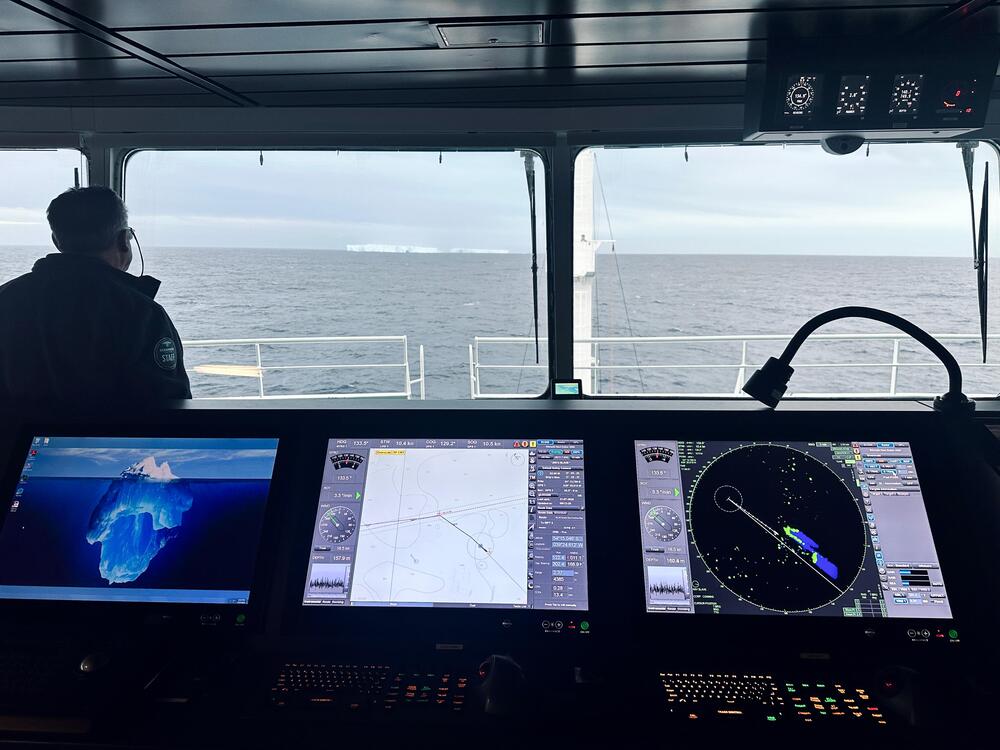So you’ve booked a spot on one of our expeditions to Antarctica, Greenland or Tristan da Cunha. Adventure awaits: roaring waves, distant horizons, cold beers on deck… and then, it hits. That gut-churning misery known as seasickness. But what is seasickness, really? Is it a disease? A weakness? A rite of passage for the intrepid traveller? Here’s the science, history, and practical survival tips behind one of humanity’s oldest foes.
Table of Contents
What is seasickness?
First things first: seasickness isn’t a disease. It’s a condition; a temporary (thankfully) state triggered by motion, particularly motion your body can’t quite reconcile.
Here’s how it works:
Your eyes report that you’re in a stable environment. Say, a cabin below deck. Meanwhile, your inner ear is screaming “We’re moving!” Inside your inner ear are tiny calcium crystals, called otoliths, which rest on small hairs. When a ship rocks, the otoliths bounce, sending signals to your brain that you’re moving, even if your vision disagrees.
Your brain receives these mixed signals and panics: “Something’s wrong!” It activates your vomit centre as a kind of evolutionary failsafe, interpreting the mismatch as possible poisoning or neurological malfunction. Cue nausea and dizziness.

Who gets seasick?
Basically, everyone. The only people completely immune to seasickness are those with non-functioning inner ears. In other words, if your vestibular system works, it’s vulnerable.
Seasickness doesn’t care if you’re a hardened traveller or a battle-ready soldier. In fact, during World War II, seasickness was such a major problem that the US military installed gutters inside transport planes (yes, vomit gutters) for troops too sick to keep their rations down. It became such an operational issue that in 1944, the US government formed a special subcommittee to tackle it – with no tangible results.
In the late 1950s, before NASA could shoot astronauts into space, they needed to understand the effects of zero gravity and motion disorientation. Enter the Gallaudet Eleven: a group of 11 deaf men, aged 25–48, recruited from Gallaudet College (now Gallaudet University). All but one had lost their hearing to spinal meningitis, which had also destroyed the part of their inner ear responsible for balance. This made them uniquely immune to motion sickness.
NASA and the U.S. Naval School of Aviation Medicine enlisted them for a decade of intense experiments, from 12 days in a spinning rotation room to the infamous “Vomit Comet” zero-gravity flights. While researchers turned green and lost their lunch, the Gallaudet Eleven played cards and carried on without a hitch. One particularly legendary experiment took place on a ferry off Nova Scotia, where rough seas wrecked the researchers, but the test subjects remained entirely unaffected. Their work continues to influence motion sickness research today.
Why does this happen?
The simple answer: evolution hasn’t caught up with modern transportation.
Your brain is wired to detect and reject poisoning. If it senses disorientation – like conflicting messages from your eyes and ears – it assumes you’ve eaten something bad. Hence the vomiting, even though you’re perfectly healthy.
It’s a glitch. An unfortunate byproduct of our sophisticated balance system.


How do you deal with it?
There are aids, not cures. You can’t eliminate seasickness outright, but you can manage it, and even overcome it.
Here are some YPT-tested survival tips:
- Get topside. Let your eyes and ears agree on what’s happening. Watch the horizon: your brain loves a consistent visual reference.
- Don’t stay still. Move with the ship. Feel its rhythm. Standing like a statue below deck is a one-way ticket to barf town.
- Hydrate and snack, but keep it light. Dry crackers, ginger, or green apples are old sailor tricks.
- Medication like Dramamine or scopolamine patches can help, but they often cause drowsiness or other side effects.
- Avoid screens and books early on. Your eyes will tell your brain you’re in a stable world… your inner ear will beg to differ.
But the real key?
Ride the ship! But there’s a fine line. Too much motion too quickly, and you’ll trigger the worst. But too little, and you never let your vestibular system adapt. The solution lies in gradual exposure. Your brain needs time to learn the new normal, and once it does, it usually adjusts.
Even the most sea-sensitive pioneers often find they’re fine after a day or two on the water.
Seasickness is ancient, irritating, and deeply humbling. But it’s also just part of the deal when you’re a modern explorer. You’re not broken. You’re just human. So the next time you’re leaning over the rail, whispering prayers to Poseidon, remember: even elite astronauts and battle-hardened soldiers have been there. And even fish get seasick!
So breathe. Sip some ginger tea. And keep your eyes on the horizon.





